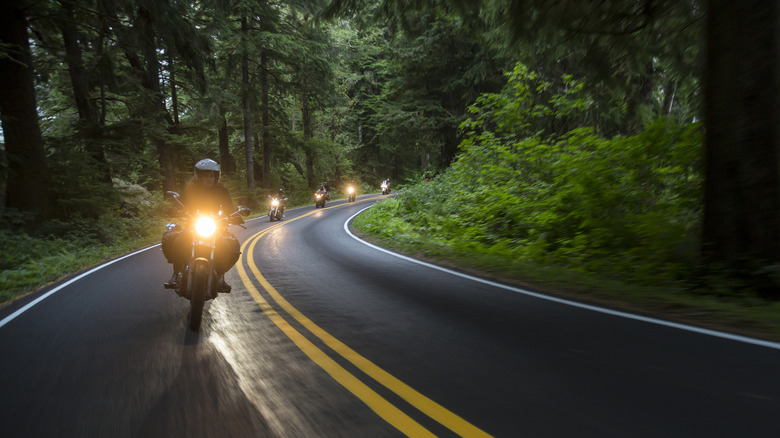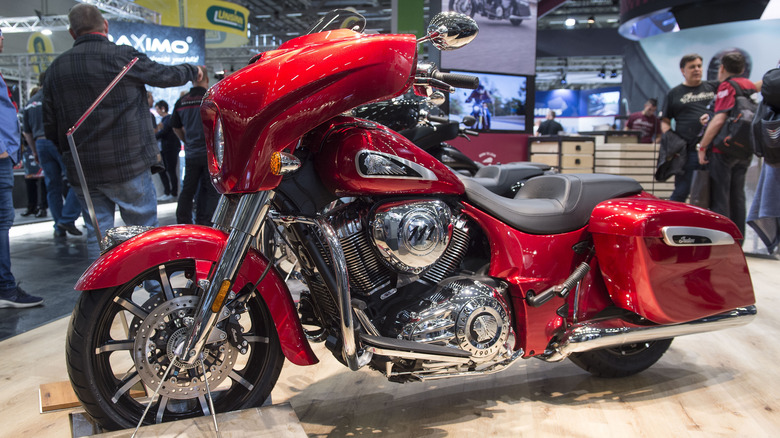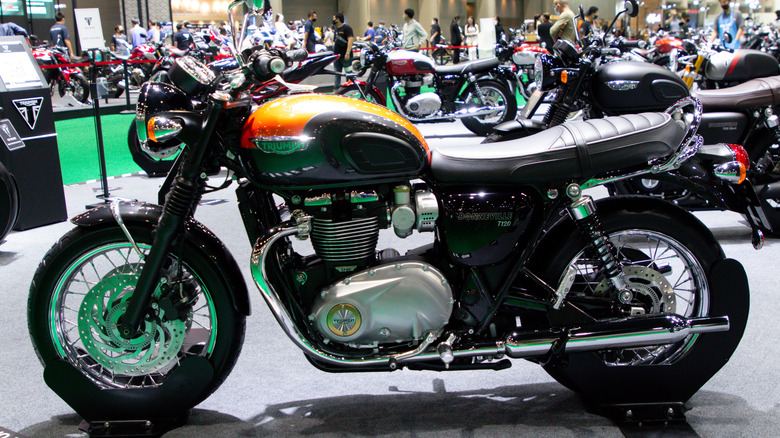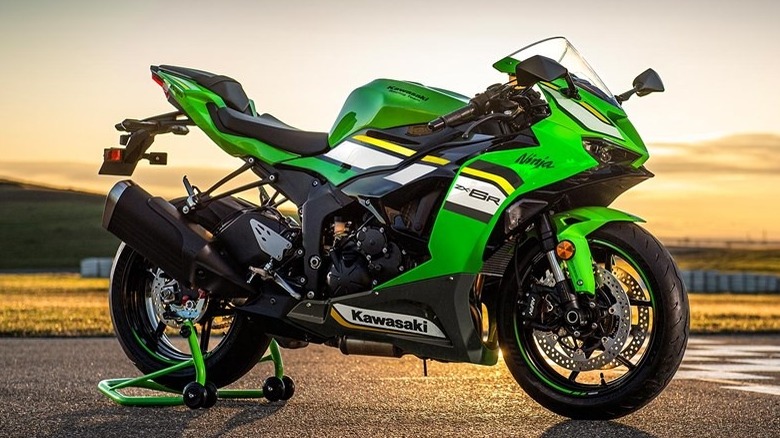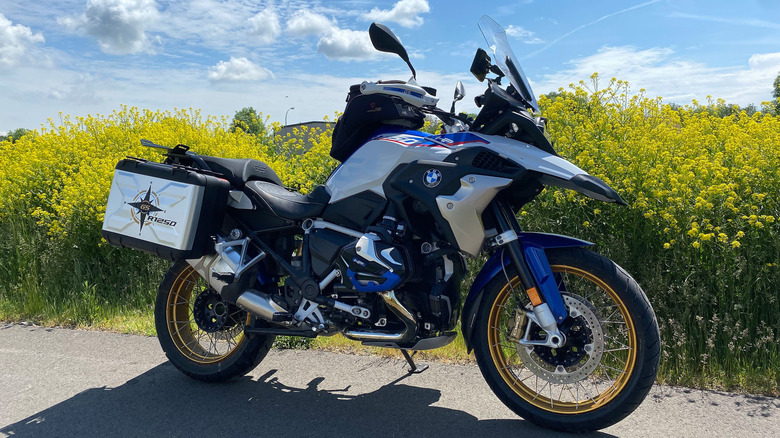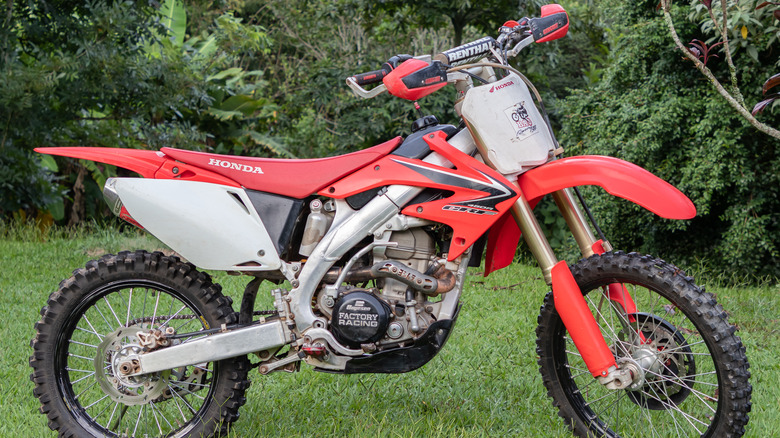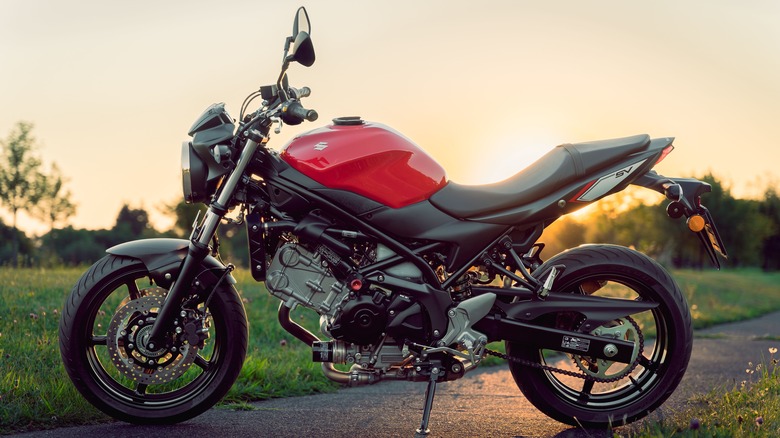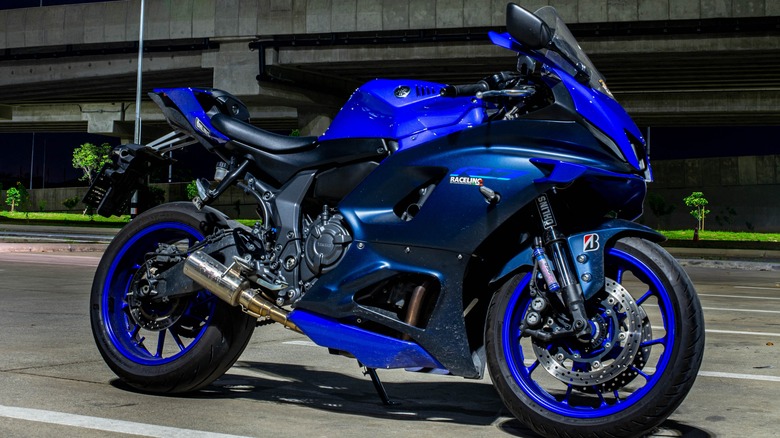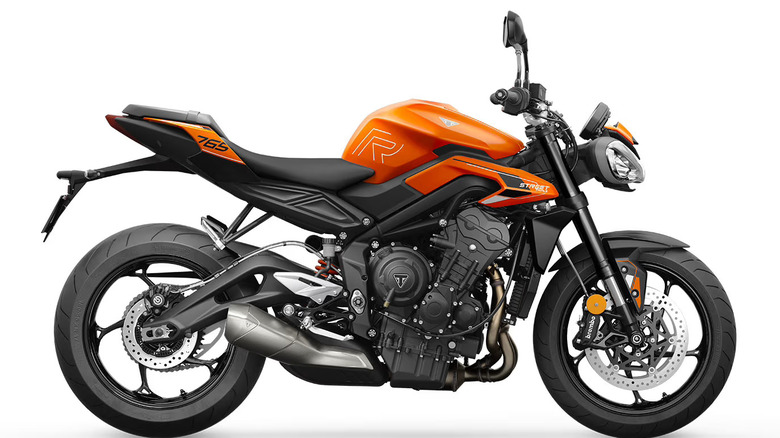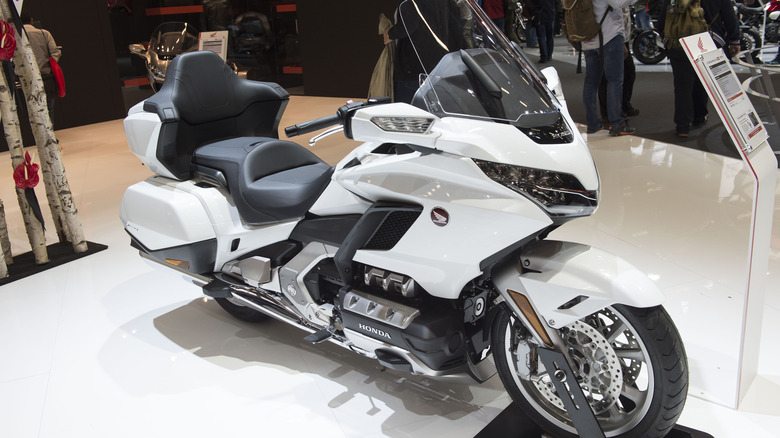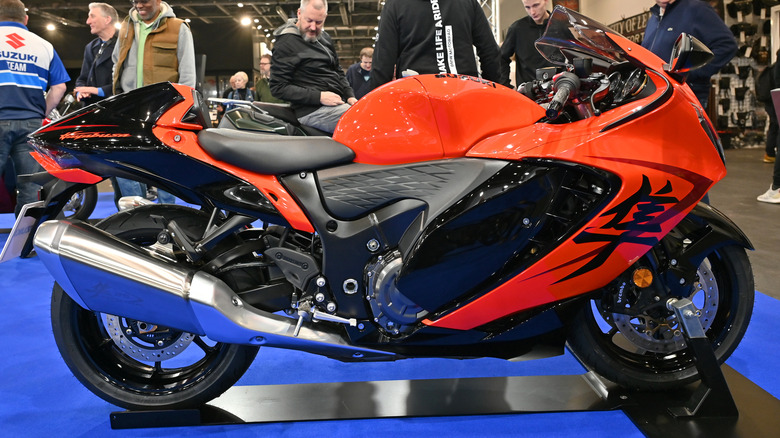10 Of The Most Popular Motorcycles In The US That Aren't Made By Harley-Davidson
It makes sense that Harley-Davidson owns the largest share of the American motorcycle market. Home-field advantage has to mean something, after all. Still, America's motorcycling landscape is a diverse paradise. With its expansive highway system, varied terrain and climates, and vast wilderness, there's a ride for every type of rider. Since the majority of Harley-Davidsons are V-twin cruisers, many motorcyclists turn elsewhere to fulfill their needs.
The big four Japanese manufacturers make a dizzying array of bikes. From robust cruisers to sleek sportbikes, grunty dual sports, and buzzy dirt bikes, it should be no surprise that Honda is hot on Harley's heels. Yamaha, Suzuki, and Kawasaki all sell a number of popular models, and BMW has a foothold in the U.S. motorcycle market as well. The bottom line is there are plenty of non-Harley bikes to choose from in the United States.
If a Harley is on your wish list, check out our rundown of six of the best Harley-Davidson engines ever made. Otherwise, join us as we examine 10 of the most popular motorcycles in the United States that aren't made by Harley-Davidson.
Indian Chieftain
Harley-Davidson doesn't make the only badass, V-twin, retro-style highway hellions on the road. Founded in 1901, Indian and Harley competed viciously until 1953, when Indian stopped production. Some import bikes got the nameplate, but it wasn't until Polaris bought the brand in 2011 that Indian came roaring back.
Three years after its rebirth, Indian presented the world with the Chieftain. Intended as a full-bagger cruiser, the Chieftain took square aim at the Vulcans, Gold Wings, V-Stasr, and Road Kings of the world. The Chieftain is the top-of-the-Indian line, with a Thunder Strike V-Twin, a full suite of infotainment widgets, and an impressive array of standard goodies. Anti-lock brakes, cruise control, keyless ignition, ride mode selection, rear cylinder deactivation, and a 100-watt audio system with Bluetooth make it clear that this isn't grandpappy's Chieftain.
Harley-Davidson is a polarizing brand. Polaris seems convinced there is a spot in the market for an American V-Twin bagger for the Harley haters or those who want something different. It's steady increase in global market share — which has risen from 2% to 13% between 2014 and 2023 — suggest that Indian is on to something.
Triumph Bonneville
Speaking of resurrected brands, Triumph has been fighting the good fight for almost as long as Indian. Founded in Britain, Triumph made its very first motorcycle in 1902, although the brand has had its ups and downs over the last century. While it consistently performed well on the European Tourist Trophy circuit and helped spark the cafe racer sensation, by the 1980s, the firm was in trouble. Production trickled until 1990, when an infusion of cash inspired six new models.
Since then, Triumph has relied on a combination of modern technology and vintage style. Bonneville T120 originally appeared in 1959, capturing the hearts of riders until production ceased in 1983. Its resurrection in 2016 has been a boon for motorcycle fans. The 2024 T120 fills a particular niche in the market. An around-town and Sunday ride commuter, its parallel twin, 8-valve four-stroke engine makes 79 horsepower. It's not going to blow anyone away by superbike standards, and it doesn't have the Cadillac comforts of the baggers, but it scratches a very specific itch.
For some, the T120 represents the nostalgia of the cafe days, but Triumph as a brand is slowly gaining market share with an eclectic collection of models. Some might even consider Triumph underrated, but it's quietly building a solid reputation on the back of its retro Bonnie.
Kawasaki Ninja ZX-6R
From cruising comfort to blistering speed, the Kawasaki Ninja remains a recognizable and popular choice for sportbike enthusiasts. Kawasaki has been a major player in the sportbike world for decades. Some rare Kawasaki bikes go for big bucks, and the Ninja name has always stayed in vogue — even after 40 years.
The OG GPZ900R was the first bike to use the Ninja moniker all the way back in 1984, but the ZX-6R has captured the hearts of enthusiasts for decades. Now, Kawasaki is celebrating the ZX-6R with a retro paint job hearkening back to the '90s. Of course, it's not just nostalgia that keeps sportbike lovers coming back. With a 636 cc in-line four-cylinder making 122 horsepower, a 13,000 RPM redline, modern selectable power modes, a sleek digital dash, and a race-oriented suspension suitable for track or road, the Ninja is the hobbyist's dream. This is a bike that is perfectly rideable on the street and perfectly raceable on the track.
What sets the Ninja above the other big four supersport offerings? Yamaha is out of that class, with its R7 bumping up in displacement. That just leaves Suzuki and Honda. The GSX-R and CBR are fantastic sports bikes, but there's something about the Ninja's legacy that keeps it squarely in the center of the supersport zeitgeist 40 years and running.
BMW R 1250 GS
There is a significant demand for motorcycles that can go anywhere, and the BMW 1250 GS may be the king of stepping off the roadway. While BMW only claims a slim percentage of the market share in the United States, BMW's premier adventure bike has an outsize impact.
There are plenty of common knocks against BMW. They're expensive and can be a pain to work on — not to mention all the rumors about how BMW drivers behave on the road. Luckily, GS riders can escape that last one by heading into the wilderness. BMW has been making the GS line since 1980, but it's the latest generation we're interested in.
With a 50 cc boost from the BMW R 1200 GS, the 1250 pulls many of the same tricks with a little extra grunt. Though its horizontally opposed Boxer engine is complex, it is nearly bulletproof and provides plenty of usable power through the range. Extensive rails integrated into the frame, bark buster knuckle guards, and a skid plate make it clear that this enduro-tourer puts a premium on the enduro part.
Some claim that dual sports don't do either thing well, but the BMW is an exception. This go-anywhere dynamo of motorcycle technology inspires a passionate pantheon of adventure riders who won't settle for anything less than the GS. Sales are going strong, and even with intense competition from the likes of the Africa Twin and others, the GS 1250 seems to reign supreme.
Honda CRF450
Forget going off-road temporarily. Some riders want to avoid being on it in the first place. America is a wonderland for dirt riders. Its varied terrain, plethora of trails and tracks, and breathtaking natural beauty make it a prime spot for dirt riders.
Honda dirt bikes have a bit of a two-faced reputation. While some say Honda built the best dirt bike ever made, Honda doesn't dominate the motocross track as it once did. Of course, most of us aren't professional (or amateur, for that matter) motocross riders, and there's plenty of fun to be had in the dirt that doesn't involve a podium. Honda's reputation for solid build quality and forgiving fun lives in its big boy dirt offering: the CRF450.
A 450 may be a little big for an amateur rider, but Honda remains popular for racing and trail riding. Developed to replace the two-stroke CR250R, the four-stroke 450 hit the market in 2002. With a broader power band than the two-strokes, it quickly became a favorite for racing and trail riding.
Honda has updated the 450 throughout the years, with seven generations available at the time of writing. Part of why this bike is so popular may be the sheer availability — 20 years of production equals a lot of used bikes to pick from. Honda owns the largest non-Harley share of the American market, so it's no surprise that its flagship big-bore dirtbike demands loyalty from dirt riders.
Suzuki SV650
With just a slightly larger share of the American motorcycle market than BMW, Suzuki nonetheless has found a niche at which it excels: the V-twin sportbike. After all, not all supersports have to have screaming in-line four cylinders — plenty of riders like the torquey pull of a twin, and that's where the SV650 comes in.
The SV line has been on the market in various forms since 1984. It has been a half-naked streetfighter, a full-fairing facsimile of the super sports, and even a rugged scrambler. Owners have praised the SV650 as ergonomic and intuitive, which goes a long way in a world of unreachable handlebars and masochistic footpeg placements. Aside from its accessibility, it is also popular as a bike that is friendly to beginners but provides enough power and excitement to grow into.
The SV also comes in a 1,000 cubic centimeter model configuration, but the 645 cc 90-degree twin has enough power. The engine produces 75 horsepower and 47 foot-pounds of torque — a manageable but exciting level. The SV650 might be an acquired taste for some, as many people who go for sports bikes prefer the blistering power of an in-line four and the letter R somewhere on the decals. Still, there's a space for V-twin lovers looking to scoot around town or enjoy a longer ride on this versatile all-rounder.
Yamaha R6/R7
Yamaha debuted what would become a legend in 1998 with its YZF-R6. A sleek and powerful middleweight 600, the R6 was ridden by generations before discontinuing it in 2020. Known more for speed and handling than comfort, the R6 was a pure race bike. Despite the Euro 5 emissions regulations that ultimately put the R6 in an early grave, tons of them are still zipping around America's highways and byways.
Though it is unfortunate to lose a legend, Yamaha did not leave R6 fans with no recourse, with the YZF-R7 first appearing as a 2022 model. The 700 cc displacement seems strange in a world of supersport bike market traditionally dominated by 600 and 1,000 cc engines, but times are changing – Yamaha offers R1, R3, and R7 options for riders from beginners to experts, not to mention the thousands of R6s still floating around.
The R6 was a pure racebike that was good at what it did, but the R7 is a different type of machine. With the engine from Yamaha's MT-07, the 689 cc parallel twin makes 72 horsepower, a major reduction of the 2020 R6's 120 horsepower. However, Yamaha wants the R7 to be more accessible than the race machine R6, and they've done so by producing a popular bike that's just plain fun to ride.
Triumph Street Triple 765
Triumph scored one of the best-selling bikes of 2023 with its oddball Street Triple 765. As noted earlier, Triumph is developing one heck of a comeback, and the idiosyncratic Speed Triple scores rave reviews and good sales numbers.
The Triple in the name indicates one of its most unusual characteristics — an engine with three cylinders. Triumph proved that thinking outside the box is part of its process in a world of every imaginable four and two-cylinder configuration. The strangeness extends to the design. With an alien (that's not necessarily a drawback) bug-eyed headlight and sharply angled half-fairings, the 765 is an absolute head-turner.
Triumph has been building triple-cylinder sportbikes since the 2008 debut of the Street Triple, and they are currently the exclusive supplier of these engines to the Moto2 World Championship. Perhaps the price tag is the most surprising thing about this bike, other than its looks and engine. The base R spec is priced at $10,945. For that, you get 116 horsepower, Brembo brakes, and a Showa suspension. That's a mouth-watering deal in a world of inflated auto prices. The higher specced RS and Moto2 models come in at $12,595 and $15,395, each getting a little more power and some extra goodies.
Honda Gold Wing
Since its debut in 1975, the Honda Gold Wing has become the standard for touring luxury. Initially, it wasn't a full-on bagger, but Honda made big strides and made it one beginning in 1984. Luxuries like a windscreen, radio, air suspension, and seats you could sit in to watch a baseball game took some of the discomfort out of cycling.
Fast-forward to today's model, and the package is distinctly more sophisticated. There isn't a comfort-oriented gizmo or gadget you can't find on the top-tier 2024 Gold Wing. Brand new, it will set buyers back $24,700, but the model's extended career means there are plenty of used ones out there if you don't want to break the bank.
The Gold Wing is the current king of the tourers because Honda has created a rider-centered experience. It's hard to white-knuckle on a Gold Wing with the smooth and balanced power delivery of the flat-six, a fat windscreen to view America from behind, and everything from cupholders to hand warmers.
It's big and bulky, and it might get laughed at by the superbike set, but no one is more comfortable on the road than Gold Wing owners. Its longevity and passionate fanbase are evidence of why it's one of the most popular bikes around, not to mention one of the most successful Honda motorcycles in history.
Suzuki Hayabusa
The longtime champion of the superbike power wars, the Hayabusa, is all over America's roadways. Certain riders want the fastest thing on two wheels in their garage, and for nearly 25 years, that has been the Hayabusa. Kawasaki's absurd Ninja H2R has recently dethroned the beloved 'Busa, but that doesn't stop enthusiasts from wheelieing themselves into oblivion on Suzuki's insult to physics.
The Hayabusa is distinctive. Its curvaceous (some might say bulbous) fairings hid a 1,300cc in-line four-cylinder engine that screams. Capable of a top speed of 194 miles per hour, the Hayabusa is not suited for the beginner rider or the faint of heart.
It doesn't look like Suzuki is slowing down, either. The third generation Hayabusa dropped in 2021 with a redesigned fairing that introduces some angles to what remains unquestionably a Hayabusa. After all, what's the point of having one if no one knows what it is?
Of course, the Hayabusa is more than just a showpiece. It's an ultra-competent supersport behemoth that hangs with the biggest dogs in the pack — that's why its quarter-century popularity streak shows little signs of slowing down.
